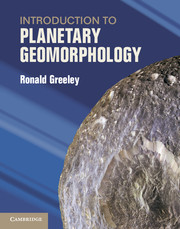Book contents
- Frontmatter
- Contents
- Foreword
- Preface
- Acknowledgments
- Chapter 1 Introduction
- Chapter 2 Planetary geomorphology methods
- Chapter 3 Planetary morphologic processes
- Chapter 4 Earth’s Moon
- Chapter 5 Mercury
- Chapter 6 Venus
- Chapter 7 Mars
- Chapter 8 The Jupiter system
- Chapter 9 The Saturn system
- Chapter 10 The Uranus and Neptune systems
- Chapter 11 Planetary geoscience future
- Appendices
- References
- Further Reading
- Index
Chapter 4 - Earth’s Moon
Published online by Cambridge University Press: 05 February 2013
- Frontmatter
- Contents
- Foreword
- Preface
- Acknowledgments
- Chapter 1 Introduction
- Chapter 2 Planetary geomorphology methods
- Chapter 3 Planetary morphologic processes
- Chapter 4 Earth’s Moon
- Chapter 5 Mercury
- Chapter 6 Venus
- Chapter 7 Mars
- Chapter 8 The Jupiter system
- Chapter 9 The Saturn system
- Chapter 10 The Uranus and Neptune systems
- Chapter 11 Planetary geoscience future
- Appendices
- References
- Further Reading
- Index
Summary
Introduction
Throughout the history of humankind, other than the Sun, no other planetary object has held our attention as much as the Moon. The Moon figures prominently in mythology and literature, with notions of vampires and werewolves that were driven by the phases of the Moon. The very term “lunatic” derives from the idea that mentally unstable individuals are influenced by the Moon. Aside from these aspects, scientifically, the Moon holds much for study, especially in terms of planetary geomorphology. Even with the naked eye, we can see that its surface is not uniform. Some areas are dark and circular (the “eyes” of the Man in the Moon) and other areas are very bright. These characteristics led to the terms maria (Latin for seas) for the dark areas for their fanciful resemblance to water areas and terrae (Latin for land), or highlands, for the notion that there were continents surrounding the seas.
At 3,476 km, the diameter of the Moon is nearly the width of the United States; its surface area of 3.79 × 107 km2 is about the same as the land area of Africa and Australia combined. In many ways, the Earth–Moon system is unique in the Solar System, and, because the Moon is comparatively so large, some planetary scientists view Earth–Moon as a “binary” planet. As is true with many natural satellites, our Moon is locked in synchronous rotation in its orbit around Earth, meaning that it always shows the same “face,” termed the near side, toward Earth and hides the far side from direct viewing (Fig. 4.1). Librations, or “wobbles,” in the Moon’s movement enable slightly more than a hemisphere to be seen in both polar areas and on the eastern and western sides, or limbs, of the Moon.
- Type
- Chapter
- Information
- Introduction to Planetary Geomorphology , pp. 59 - 90Publisher: Cambridge University PressPrint publication year: 2013



